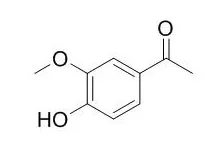| In vitro: |
| Toxicol Appl Pharmacol. 2006 May 1;212(3):179-87. Epub 2005 Aug 24. | | The NADPH oxidase inhibitor apocynin (acetovanillone) induces oxidative stress.[Pubmed: 16120450] | Apocynin (Acetovanillone) is often used as a specific inhibitor of NADPH oxidase.
METHODS AND RESULTS:
In N11 glial cells, apocynin induced, in a dose-dependent way, a significant increase of both malonyldialdehyde level (index of lipid peroxidation) and lactate dehydrogenase release (index of a cytotoxic effect). Apocynin evoked also, in a significant way, an increase of H(2)O(2) concentration and a decrease of the intracellular glutathione/glutathione disulfide ratio, accompanied by augmented efflux of glutathione and glutathione disulfide. Apocynin induced the activation of both pentose phosphate pathway and tricarboxylic acid cycle, which was blocked when the cells were incubated with glutathione together with apocynin. The cell incubation with glutathione prevented also the apocynin-induced increase of malonyldialdehyde generation and lactate dehydrogenase leakage. Apocynin exerted an oxidant effect also in a cell-free system: indeed, in aqueous solution, it evoked a faster oxidation of the thiols glutathione and dithiothreitol, and elicited the generation of reactive oxygen species, mainly superoxide anions.
CONCLUSIONS:
Our results suggest that apocynin per se can induce an oxidative stress and exert a cytotoxic effect in N11 cells and other cell types, and that some effects of apocynin in in vitro and in vivo experimental models should be interpreted with caution. | | Applied Microbiology & Biotechnology, 2008 , 81 (4) :783-90. | | Synergistic effect of laccase mediators on pentachlorophenol removal by Ganoderma lucidum laccase.[Pubmed: 18987855] | Laccases have low redox potentials limiting their environmental and industrial applications. The use of laccase mediators has proven to be an effective approach for overcoming the low redox potentials. However, knowledge about the role played by the mediator cocktails in such a laccase-mediator system (LMS) is scarce.
METHODS AND RESULTS:
Here, we assembled different dual-agent mediator cocktails containing 2,2'-azino-bis-(3-ethylbenzothiazoline-6-sulfonate) (ABTS), vanillin, and/or Acetovanillone, and compared their mediating capabilities with those of each individual mediator alone in oxidation of pentachlorophenol (PCP) by Ganoderma lucidum laccase. Cocktails containing ABTS and either vanillin or Acetovanillone strongly promoted PCP removal compared to the use of each mediator alone. The removal enhancement was correlated with mediator molar ratios of the cocktails and incubation times. Analysis of the kinetic constants for each mediator compound showed that G. lucidum laccase was very prone to react with ABTS rather than vanillin and Acetovanillone in the cocktails. Moreover, the presence of the ABTS radical (ABTS+*) and vanillin or Acetovanillone significantly enhanced PCP removal concomitant with electron transfer from vanillin or Acetovanillone to ABTS+*.
CONCLUSIONS:
These results strongly suggest that vanillin and Acetovanillone mediate the reaction between ABTS and PCP via multiple sequential electron transfers among laccase and its mediators. |
|






 Cell. 2018 Jan 11;172(1-2):249-261.e12. doi: 10.1016/j.cell.2017.12.019.IF=36.216(2019)
Cell. 2018 Jan 11;172(1-2):249-261.e12. doi: 10.1016/j.cell.2017.12.019.IF=36.216(2019) Cell Metab. 2020 Mar 3;31(3):534-548.e5. doi: 10.1016/j.cmet.2020.01.002.IF=22.415(2019)
Cell Metab. 2020 Mar 3;31(3):534-548.e5. doi: 10.1016/j.cmet.2020.01.002.IF=22.415(2019) Mol Cell. 2017 Nov 16;68(4):673-685.e6. doi: 10.1016/j.molcel.2017.10.022.IF=14.548(2019)
Mol Cell. 2017 Nov 16;68(4):673-685.e6. doi: 10.1016/j.molcel.2017.10.022.IF=14.548(2019)